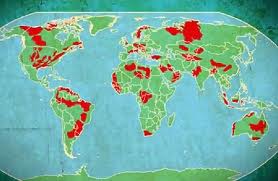By S. Tom Bond of Lewis County, WV
The Wall Street Journal article “Global Gas Push Stalls,” published on December 2nd represents a major shift in the shale drilling story. No longer is the Marcellus the largest shale field in the world, the “Saudi Arabia of the U. S.”
No longer is the U. S. presented as the world leader in gas reserves. It is in fact, Russia and the Middle East that come up the winner in shale hydrocarbon reserves — areas no longer in the control of the major oil companies — taking over control themselves.
Why are the drillers surprised that the Polish rural people resist drilling? That they aren’t susceptible to assurances no harm will come to their water and land? Have these leaders forgotten how the industry behaved in Liberia and Ecuador? Or forgotten the endless problems they caused here in the homeland of shale drilling?
Why are the drillers surprised it costs more to drill in countries where the industry hasn’t established necessary infrastructure, the roads are bad and great distances are involved? The “enormous irrational exuberance for global shale development,” the lack of planning, mentioned in WSJ’s article sounds like a 13-year old’s over active imagination.
So this is going to give the U. S. “a significant competitive advantage.” If it works out to the industry’s wish, the “vast sucking sound” you hear will be U. S. gas leaving the country, with citizens, truck fleet owners and electric companies that have switched to gas with very expensive fuel. But not like some very well-off major investors.
You have to grin when you hear “In the Polish village of Lubocino, a farming community near the Baltic Sea, state-controlled energy company PGNiG SA has tried hard to convince locals that shale development is both safe and of benefit to them.” (with no royalty) followed by “the only jobs offered to Lubocino residents at the drilling site have been security guard and cleaning lady.” A villager who sold PGNiG SA the land where the well was drilled said company officials told him the state owned the gas underneath his land and threatened to expropriate some of his 14 acres where the drilling pad was located. The technique sounds so familiar.
In China the land is too dry or too heavily populated (even relatively small towns have four or five story dwellings) to find enough water. “To create a flat drilling pad, we almost always have to take out some part of a hillside and basically someone’s rice paddy,” says Simon Henry, of Royal Dutch Shell. In Argentina, a Spanish Company, YPF SA, screwed up the water where they were drilling and it has to be hauled 38 miles for the natives. The complaints: skin disease, diarrhea and blindness. So Argentina is being difficult. France and Bulgaria have banned hydraulic fracturing.
The “white elephant in the room,” global warming, was ignored in the article — never mentioned. As you might expect, WSJ’s article was totally devoted to production of carbon fuel. We need alternate energy sources that do not devastate the landscape now or ruin all landscapes by slowly roasting the earth.


{ 2 comments… read them below or add one }
The URL furnished to the WSJ article by FrackCheck’s article requires membership in the WSJ’s online edition to open.
Try this one:
http://www.stockhouse.com/bullboards/messagedetail.aspx?p=0&m=31856514&s=cdh&t=LIST&l=0&r=0
The FrackCheck characterization of the WSJ article is heavily slanted – it injects dogmatic, anti-drilling opinion not found in the WSJ article.
Reply to RD Blakeslee . . .
My posted article is a comment ON the WSJ article, not a rehash. The phrase — even relatively small towns have four or five story dwellings — doesn’t appear in the article, it’s my observation.
Thanks for supplying a better reference. . . . Tom